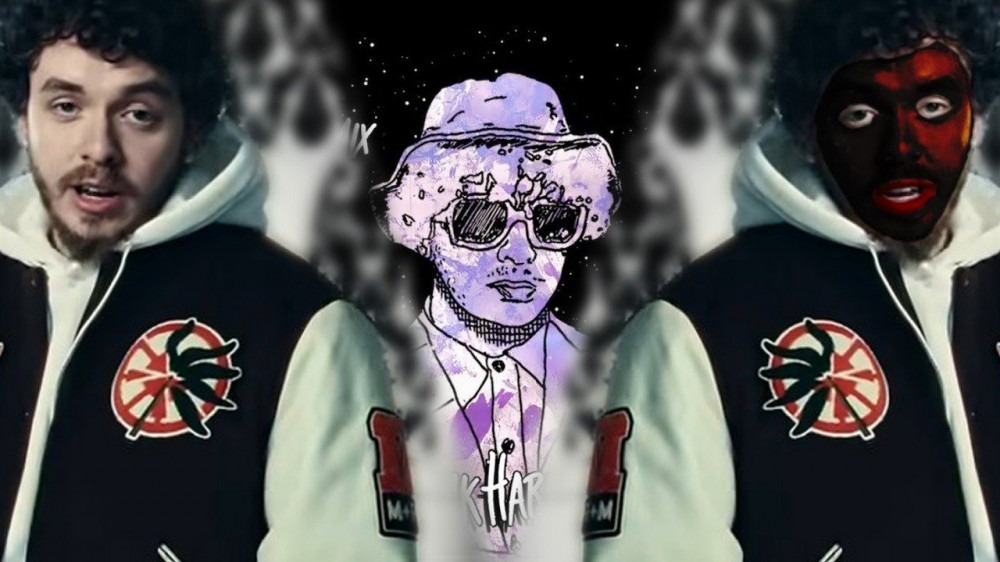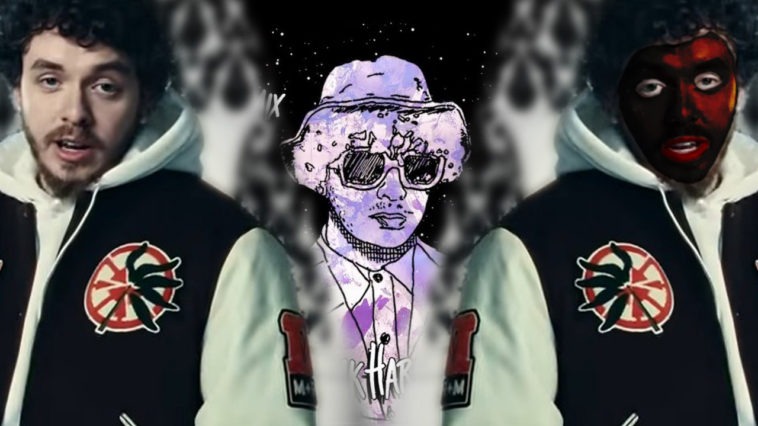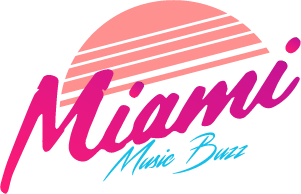
Jack Harlow’s Come Home The Kids Miss You has garnered him a position at the top of the charts with over 100,000 units sold his first week, a privilege not enjoyed in recent weeks by Kodak Black, Fivio Foreign and Pusha T. Here’s how the relative newcomer used digital blackface, acts of social justice, and a bag of cash to slip into the top of the hip-hop charts.

278 Views
Comments Off on How Jack Harlow Finessed Hip-Hop Fans Using Digital Blackface, Big Money & Performative Allyship
Who’s Ray J’s Sister?
During a May 11 interview with New York’s Hot 97, radio host Ebro Darden and crew challenged Jack Harlow to a game in which the rapper had to guess the song playing on the radio. Darden put on Brandy’s 1998 hit, “Angel in Disguise,” which Harlow didn’t recognize and guessed Aaliyah instead. He encouraged Harlow to keep guessing and eventually started giving him hints. “She had a TV show. She starred in a TV show.”
Harlow got another hint, this time referring to Ray J. The “Whats Poppin” rapper eventually guessed, “Who’s Ray J’s sister?”
At that moment, the radio hosts revealed that Brandy sang “Angel in Disguise.” Harlow asked in surprise, “Brandy and Ray J are siblings?”
“Nobody’s ever told me that in my life,” he said.
Black Twitter had a field day with this moment that momentarily uncovered Harlow as the boy who grew up studying the culture as an outsider whose experiences as a white male in no way resembled those he emulated. Many were frustrated that Harlow performed music created and nurtured by the Black community but lacked knowledge about some of the genre’s most influential stars. Others cited his young age, reasoning he might not have recognized a Brandy hit.
.@jackharlow finds out Brandy and Ray J are siblings during interview to HO7 97 pic.twitter.com/dIFcbLOaP1
— Brandy Legion (@BrandyLegion) May 11, 2022
Musical icon India Arie commented on the situation, voicing the frustration of those who watched Harlow emerge from God knows where.
“Just because you make black [music] doesnt mean you know black culture,” she wrote on her Instagram Story. “If U dont know Brandys voice when you hear it …. WHO EVEN ARE YOU?” In another slide she continued, “When an ACTUAL MUSICIAN! WHO MAKES BLACK MUSIC! Deduces ones of the industries MOST IMPORTANT VOICES! @brandy To Ray Jays SISTER who is famous (mostly) for his Proximity to Kim Kardashians.”
Becoming Jack Harlow The Rapper
Jack Harlow was born in mostly-white Louisville, Kentucky in March 1998 to Maggie Harlow and Brian Harlow. According to a piece by Forbes, his mom would often play Eminem tracks while carrying him “in utero”. Jack often cites her for developing his interest in rap.
It was revealed that Harlow succeeded in English class and enjoyed writing stories. This is where pre-fame Harlow claimed he learned from his father – who often told his son “I love you” – the art of vulnerability and authenticity which he weaves into his narratives.
His mother, meanwhile, would play Eminen while she was pregnant with him and even encouraged him to pursue Hip-hop. At some point, via his passion for singing and Eminem, Harlow discovered the rap scene.
“The writing, the storytelling, the rhythm of it – I was so attracted to it,” he says. “It made you move, made you dance, feel confident; it made you feel like the man.”
“What’s Poppin” and The New Blackface
Jack Harlow took 2020 by storm with “WHAT’S POPPIN.” The song went viral on TikTok, garnering over 300,000 glow-up videos that featured the song and its catchy piano riff. It was later buoyed by music video director and producer Cole Bennett of Lyrical Lemonade, whose 15 million Youtube subscribers pushed the original video to over 130 million views within a year, earning him a modest base.
But it would be his next move that would bring him mainstream success and mass appeal. In June 2020, he financed his way into the hearts and minds of hip-hop fans. Harlow would drop an undisclosed six figure sum to buy three of hip-hop’s most expensive features – DaBaby, Tory Lanez and Lil Wayne – for the remix of “What’s Poppin’.” Estimates of what Harlow invested in the catchy remix are between $500,000 to $750,000 based on what each of these artists purportedly charge for a feature. (And that’s not even including the fees to get all three of them to appear in the music video.)
The cover art for the remix was deceptively race ambiguous. It displayed the four men as colorless pencil sketches, with Harlow in the center drawn slightly bigger, making him appear in the foreground with the three Hip-Hop stars flanked behind him. Harlow’s soft curly locks were sketched under a blue bucket hat to look like a messy afro, his nose slightly more round and wide, his blue-green eyes hidden behind dark shades.

With Lil Wayne, DaBaby, and Torey Lanez providing black “cover” as front men on the remix, “What’s Poppin’” became Harlow’s first number one on the Billboard chart. Vulture magazine called it “the song of the summer” and anticipation was building to find out who is the slick-sounding newcomer, Jack Harlow.
By the time the remix music video hit YouTube almost a month later unveiling Harlow as white, the “Come Home The Kids Miss You” rapper was up and stuck. Clearly, the dude could rap and the paid co-signs by the rap elite made him undeniable. And the subversive strategy made sense considering the origination and dominance of Hip-Hop as a black cultural artform where whites have not been as accepted or influential. All Harlow had to do now was continue to show himself to be an ally to the culture, which he would demonstrate in the months to come.
Harlow’s Digital Blackface
Harlow’s maneuvers to flip his glow-up on Tik Tok into hip-hop bonafides can be seen in the context of a wider and growing trend known as “digital blackface.”
Digital blackface is defined as the practice of using the cover of online anonymity to present oneself, either unintentionally or intentionally as Black person. This comes in varying forms, ranging from non-Black people using the images and voices of Black individuals as a way to convey emotions or phenomena to using said images to claim Black identity, but do not identify as Black.
WIRED, when discussing the rise of digital blackface, differentiates how digital blackface is being performed on Facebook, Twitter, and TikTok. They note that Facebook and Twitter, where digital blackface is rooted in text, using and misusing AAVE, and images, memes, reaction images, or gifs of Black celebrities and private citizens, Tik Tok is more problematic.
WIRED cites TikTok – where “What’s Poppin” blew up – that allows users to disguise themselves in a cape of blackness saying “On the app, users drape themselves in the trappings of Black culture—and steal the viral spotlight. It’s exploitation at its most refined and disturbing.”
Digital blackface allows blackness to be demonstrated as a costume through and through, custom-fitted to fit the appropriators who seek to wear it.
Is Jack Harlow Truly an Ally To the Culture?
While Jack Harlow has profited off the culture, he is also fallen into the most infamous aspect of Hip-hop and Black culture: propping Black and brown women in his music videos, promotional posters, his album cover as arm candy and/or sex symbols.
He’s also consorted with artists who have a checkered history with women. He worked with Chris Brown, who had once again been accused of abuse, and cried neutral when questioned about Tory Lanez on his “What’s Poppin” remix after rapper Megan Thee Stallion alleged that Lanez shot her in July 2020.
Harlow was asked about removing Lanez off the track in December 2021 by Rolling Stone. “I don’t have no room to judge anybody. “I wasn’t there when this and that happened. I don’t know anything.”
“I know I’m a good person,” said the rapper in a Rolling Stone interview. “My character, my integrity are very important to me. And I think I’ve done such a good job that now I’m being forced to answer for other people’s actions. It doesn’t feel right as a grown man to speak for other grown men all the time. . . . One thing’s for sure, is that Megan got shot. And I wish her nothing but love and respect.”
Yet at the same time, he has publicly shown his support for the Black community, especially during the summer 2020 protests. When Breonna Taylor was murdered in Louisville, Harlow marched in the streets of Louisville alongside protestors to support the demands for justice. Some would label this as performative allyship, but Harlow maintains he was taking a stand.
“It was a no-brainer for me in terms of where I stood on the topic,” Harlow told Footwearnews. “There was a gravity to what was going on where you felt like you had a responsibility. Where are you going to fall? You can’t be on the fence for this.”
Despite the fact that Harlow has been widely accepted into a genre that was created by Blackness, he himself said it’s not enough for him to just make good music. He shared his advocacy for marching against injustice.
“But what is important is that I lead by example for all the white kids looking at me. This is what you do. You don’t just enjoy Black culture. You stand up next to Black people in a time of need.”
Harlow also demonstrated support for Black women when graphic footage surfaced of an officer grabbing a young woman by the neck after one of his shows.
In a statement shared via Instagram with a brief clip of the incident in question, Harlow explained that the footage had been brought to his attention by a fan and that he chose to use his platform to bring it to light.
“I told the world to help me identify her so I could find a way to give her a hug and give her as many tickets to as many shows as she wants,” Harlow said. “But that’s not enough and it’s not a solution to a systemic issue that people who don’t look like me have to face. The next step is identifying this police officer and getting him unemployed as fast as we can.”
“I want this woman, and every black woman that supports me to know—I am so sorry,” he said, as seen in full below. “I want you to be protected and I want this guy to lose his job so fucking fast. I love you. Let’s find this officer.”
Some responded that Harlow’s post was motivated by the desire for PR and to get more likes. Harlow did not post a reply with the status of the police officer’s job or the woman in the video.
